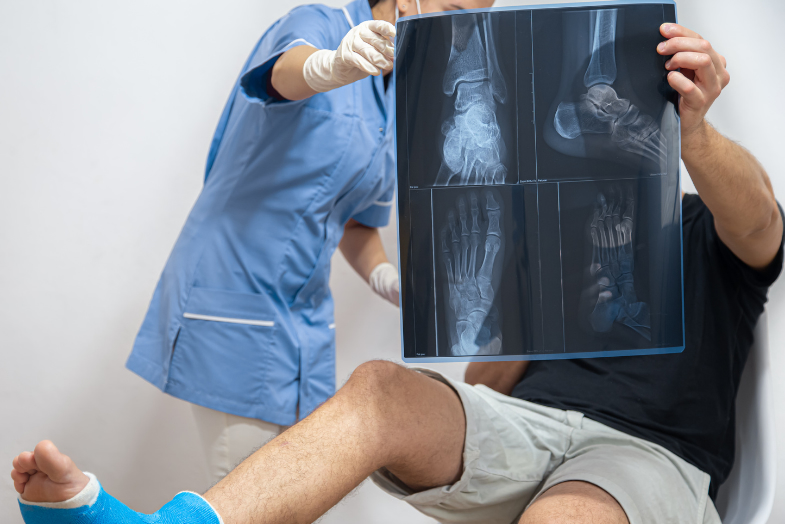Signs a Broken Bone Is Healing
When you break one of your bones, it can feel like forever before you can perform your daily activities and hobbies as before. Fortunately, in the majority of cases, a broken bone fully heals in just a few months. During these months, you may notice a few signs that your broken bone is starting to repair itself. The healing process for a bone break involves a multi-step process that begins almost as soon as you break the bone. In this article, we’ll discuss some of the signs a broken bone is healing, including how long it takes a bone to heal, what bone pain feels like, the bone healing process, and how to promote healing so you can get back to normal life sooner.
 What Does Bone Pain Feel Like?
What Does Bone Pain Feel Like?
Joint, muscle, and bone pain can affect similar parts of the body. Because these types of pain can affect similar body parts, it can be difficult to determine the difference between them. You can feel muscle aches or pain after an intense workout or when you have the flu. You can feel aches in your joints, such as in your knees, elbow, or ankles from arthritis or age. Bone pains, however, typically feel sharper, more intense, or deeper than other pains. Muscle pains also feel more generalized in the parts of the body and tend to ease after one or two days. Bone pain tends to have more focus in an area of the body and lasts longer.
You should always take bone pain seriously to avoid a worsening condition or another advanced medical condition. If you have a sharp, new bone pain, you may have a broken bone. This injury may be due to a traumatic injury, such as a fall, sports injury, or car accident. You may also have a crack in the bone, which is a stress fracture. Athletes frequently have stress fractures from body overuse during various sports activities. Osteoporosis can also lead to painful fractures. Osteoporosis makes the bones less dense over time, removing bone mass and decreasing strength in the bones of your hips, spine, and wrists.
How Long Does It Take a Bone to Heal?
When you have a broken bone, it’s important to determine with a specialist whether it is open, closed, displaced (shifted apart), or angulated. Breaks can be spiral, segmented, nondisplaced (a bone crack), or comminuted (in multiple pieces). Treatment of a broken bone can vary, with some requiring a brace, cast, or splint, and others needing surgery to repair the break with screws, nails, plates, or pins. Each person who goes through a break can heal differently. Factors that impact healing and the care undergone by a specialist both depend on the person. Influential factors can be nutrition, age, smoking habits, and overall health.
Bones generally heal in six to 12 weeks. Usually, children’s bones heal quicker than the bones of adults. A foot and ankle specialist can determine when you are ready to begin bearing weight on the affected area again. This readiness depends largely on the severity and location of the fracture, the kind of surgery performed, and other considerations. A number of factors can also slow the bone healing process, including movement, premature weight-bearing, smoking, diabetes, hormone-related issues, certain medications, advanced age, and poor nutrition. The bone healing process involves three major stages: inflammation, production, and remodeling.
Inflammation
Immediately after a bone breaks, the affected area can have inflammation. This inflammation can last for several days depending on the severity of the break. When a bone breaks, there is usually bleeding into the affected area that causes this inflammation as well as potential blood clotting at the break site. This allows for early structural stability and the framework for your body to begin producing new bone. Anti-inflammatory medicine or R.I.C.E. can help this stage.
Production
The next sign your broken bone is healing is bone production. Bone production starts when the cartilage and fibrous tissue replace the clotted blood that forms from inflammation. As your healing continues, hard bone (referred to hard callus) replaces the soft callus. A hard callus can be visible on an x-ray several weeks after the initial break. When treating a broken bone, some behaviors that can help speed up recovery and production are less movement and a proper diet.
Remodeling
During the third step of broken bone healing, your bone begins to remodel itself. This stage may go on for several months. During remodeling, the bone will continue to form and grow compact, eventually returning to its original shape. Blood circulation in the affected area will also begin to improve. After your bone has sufficiently healed, normal weight-bearing activities can resume. More severe breaks may take longer. Be sure to monitor and evaluate progress.
What Helps Promote Bone Healing?
Some of the steps to promote healing and reduce pain are decreased mobilization, continued immobilization whenever possible, consistent monitoring, and regular check-ins with a specialist. Maintaining a proper diet also goes a long way toward promoting the healing of a broken bone. Ensure that your daily diet consists of essential minerals and vitamins such as vitamin D and calcium. These are essential to the health of your bones in general. Many of these behaviors can also work to effectively prevent a broken bone from occurring or prevent future broken bones. You should also avoid alcohol and smoking, which can impact healing.
 A specialist for your broken bone can also help promote proper and speedy healing. A specialist can help you begin and continue a treatment plan with an early diagnosis and an evaluation of your pain area and the severity of your condition.
A specialist for your broken bone can also help promote proper and speedy healing. A specialist can help you begin and continue a treatment plan with an early diagnosis and an evaluation of your pain area and the severity of your condition.
Broken Bone Healing and Prevention
It can take several weeks to a few months for a broken bone to heal depending on the severity of your condition. If you are in the northwest suburbs and ready to experience speedy and proper healing of your broken bone and prevention of future breaks, consult the Foot & Ankle Specialists of Illinois (FASI) today.

